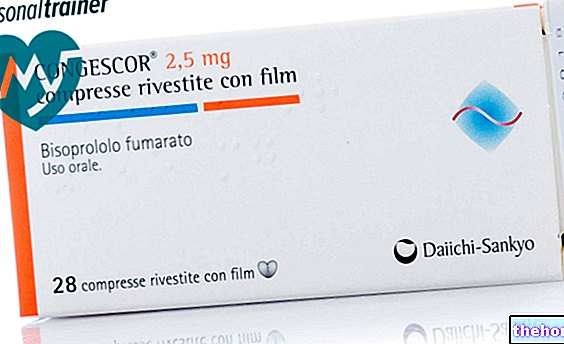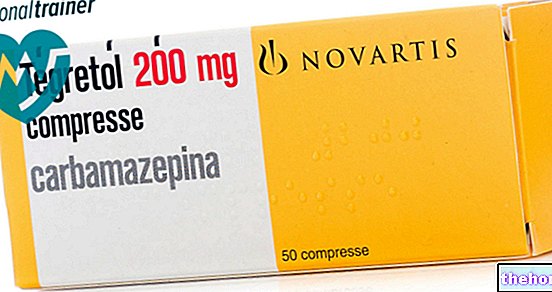Active ingredients: Tropicamide
VISUMIDRIATIC 5 mg / ml Eye drops, solution
VISUMIDRIATIC 10 mg / ml Eye drops, solution
Indications Why is Visumidriatic used? What is it for?
VISUMIDRIATIC is used when the pupil needs to be dilated:
- for the examination of the components of the eye
- to diagnose vision changes
- in inflammations of the cornea (anterior part of the eye) of the iris (the colored part surrounding the pupil) and the choroid (thin inner film with high blood distribution): keratitis, iritis, iridocyclitis, uveitis.
In all cases it replaces atropine.
Contact your doctor if you do not notice any improvement or if you notice a worsening of your symptoms after the prescribed days of therapy.
Contraindications When Visumidriatic should not be used
Do not use VISUMIDRIATIC
- if you are allergic to tropicamide, a similar substance or any of the other ingredients of this medicine (listed in section 6)
- if you have increased pressure inside the eye due to reduction or closure of the space (angle) between the iris and the cornea (narrow or closed angle glaucoma).
- Tell your doctor if either case applies to you.
Precautions for use What you need to know before taking Visumidriatic
Talk to your doctor before using VISUMIDRIATIC and use it under his supervision. The medicinal product is for ocular (ophthalmic) use only.
It is important that you wash your hands before administration to avoid contaminating your eyes with microbes. Wash your hands afterwards to avoid accidental, ie unwanted ingestion of any drug that may come into contact with your hands. If you administer Visumidriatic to a child, for the same reasons, also wash their hands well.
During the effect of the medicine, the excessive amount of light reaching the eyes due to pupillary dilation can cause disorders that vary from person to person.
He should therefore protect his eyes preferably with lenses that can filter out too intense light.
To avoid excessive general absorption, squeeze the tear sac with your fingers for one minute after instillation.
To eliminate the danger of glaucoma, an examination must be carried out to assess the depth of the area between the cornea and the crystalline lens, the lens placed inside the eye (anterior chamber).
Use with caution:
- if you are elderly
- if you have elevated pressure in your eye
- if you have urethro-prostatic problems because the medicine may cause you to retain urine
- if you have heart problems (coronary and heart failure)
- if you have brain problems or damage - especially Down syndrome, palsy and corneal disease (keratoconus).
Children and adolescents
The use of tropicamide in children is well established.
Infants, young children may be particularly sensitive to the effects of pupil-dilating drugs, such as tropicamide, which, particularly in infants and children, can cause potentially dangerous central nervous system disorders with an increased likelihood of developing side effects. Excessive use in children can induce symptoms of general (systemic) toxicity.
Administer Visumidriatic with extreme caution to infants in infancy, infants and premature babies, or to babies with Down syndrome, spastic paralysis or brain damage or keratoconus.
Interactions Which drugs or foods can change the effect of Visumidriatic
Tell your doctor or pharmacist if you are taking, have recently taken or might take any other medicines, even those obtained without a prescription.
There are no known interactions with other medicines.
Warnings It is important to know that:
Pregnancy and breastfeeding
If you are pregnant or breast-feeding, think you may be pregnant or are planning to have a baby, ask your doctor or pharmacist for advice before using this medicine.
Pregnancy
In pregnant women, the drug should be administered in case of need under the direct supervision of the doctor.
Feeding time
During lactation, the drug should be administered in case of need under the direct supervision of the doctor.
Driving and using machines
As a consequence of the pupil dilating effect, tropicamide causes visual disturbances.
- You must not drive or use machines for the duration of the effect of the drug.
VISUMIDRIATIC 1.0% Eye drops solution 10 ml bottle and VISUMIDRIATIC 0.5% Eye drops solution 10 ml bottle contain benzalkonium chloride as a preservative:
- may cause eye irritation
- do not apply the drug while wearing contact lenses
- avoid contact with soft contact lenses
- remove contact lenses before application and wait at least 15 minutes before reapplying
- the bleaching action against soft contact lenses is known.
Dosage and method of use How to use Visumidriatic: Dosage
Always take this medicine exactly as your doctor has told you.
If you are unsure, you should consult your doctor or pharmacist.
For refraction (examination of vision)
The recommended dose is:
Adults: 1 drop of VISUMIDRIATIC 1% in the eye; repeat the administration after 5 minutes.
Children and adolescents: 1 drop of VISUMIDRIATIC 0.5% or 1% in the eye. Repeat the administration after 5 minutes.
Tropicamide was inadequate for cyclopegia in children. In such cases it may be necessary to use a more potent agent, such as atropine.
In young children, do not use VISUMIDRIATIC in concentrations higher than 0.5%.
For the examination of the fundus (inside of the eye)
The dosage is: 1 or 2 drops of VISUMIDRIATIC 0.5%, 15-20 minutes before the examination. Press the lacrimal sac with your fingers for 1 minute after instillation to avoid excessive absorption in other areas of the body. .
Wash your hands before and after instillation (see also "Warnings and precautions" paragraph 2).
If you forget to use VISUMIDRIATIC
Do not use a double dose to make up for a forgotten dose.
If you have any further questions on the use of this medicine, ask your doctor or pharmacist.
Overdose What to do if you have taken too much Visumidriatic
If you apply too many drops of Visumidriatic, rinse your eyes well with lukewarm water.
If the contents of the bottle are accidentally swallowed, notify your doctor immediately or go to the nearest hospital.
The use, especially if prolonged, of products for topical use can give rise to sensitization phenomena. If this occurs, stop the treatment and inform your doctor who will submit you to a suitable therapy.
Side Effects What are the side effects of Visumidriatic
Like all medicines, this medicine can cause side effects, although not everybody gets them.
The most common side effect is:
- momentary irritation of the eye.
It can also occur:
- blurred vision
- excessive sensitivity to light (photophobia)
- slight increase in pressure inside the eye
- glaucoma (high pressure inside the eye with changes in the visual field and optic nerve) in predisposed patients
- hypersensitivity reactions.
Effects in other areas of the body are uncommon at recommended doses.
However, the following have been reported:
- cases of mental disorders characterized by loss of contact with reality, altered thinking, bizarre behavior (psychotic reactions)
- cardiorespiratory collapse.
Following ocular instillation, drugs that dilate the pupil can cause, especially in children (especially in infants or children born premature or very young) and in the elderly, toxic effects in other areas of the body (systemic) typical of this type of drugs (atropinics); in particular:
- dry mouth
- thirst
- increased heart rate (tachycardia)
- cardiorespiratory collapse
- disorders of the gastrointestinal and urinary tract
- headache
- allergic reactions
Pediatric population:
Tropicamide can cause central nervous system disorders, potentially dangerous in infants and children (see section 4.4 Special warnings and precautions for use). An increased risk of systemic toxicity has been observed with the use of cycloplegic drugs in neonates, very young or premature babies or children with Down syndrome, spastic palsy or brain damage (see section 4.4. precautions for use).
Reporting of side effects
If you get any side effects, talk to your doctor or pharmacist. This includes any possible side effects not listed in this leaflet. You can also report side effects directly via the national reporting system: http://www.agenziafarmaco.gov.it/it/responsabili. By reporting side effects you can help provide more information on the safety of this medicine
Expiry and Retention
Keep this medicine out of the sight and reach of children.
Do not use this medicine after the expiry date which is stated on the package after EXP. The expiry date refers to the last day of that month.
The expiry date refers to the product in intact packaging, correctly stored.
Do not use this medicine if you notice that the solution is not clear.
Keep away from heat sources.
Keep the multidose bottle tightly closed.
Do not use the product in the multidose bottle more than 30 days after first opening the container.
The single-dose container does not contain preservatives; the product must be used immediately after opening the container, which will be eliminated even if only partially used.
Do not throw any medicines via wastewater or household waste. Ask your pharmacist how to throw away medicines you no longer use. This will help protect the environment.
Deadline "> Other information
What VISUMIDRIATIC contains
VISUMIDRIATIC 10 mg / ml Eye drops, solution 10 ml bottle
The active ingredient is: tropicamide
100 ml of eye drops contain: tropicamide 1 g
The other ingredients are: sodium chloride, benzalkonium chloride, purified water.
VISUMIDRIATIC 5 mg / ml Eye drops, 10 ml bottle solution
The active ingredient is: tropicamide
100 ml of eye drops contain: tropicamide 0.50 g
The other ingredients are: sodium chloride, benzalkonium chloride, purified water.
VISUMIDRIATIC 5 mg / ml Eye drops, single-dose container solution
The active ingredient is: tropicamide
100 ml of eye drops contain: tropicamide 0.50 g
The other ingredients are: sodium chloride, water for injections.
Description of VISUMIDRIATIC appearance and contents of the pack
VISUMIDRIATIC Eye drops comes in the form of a solution, in packs of:
- 1 bottle 10 ml of 10 mg / ml and 5 mg / ml eye drops
- 10 single-dose containers of 0.3 ml of 5 mg / ml eye drops.
Source Package Leaflet: AIFA (Italian Medicines Agency). Content published in January 2016. The information present may not be up-to-date.
To have access to the most up-to-date version, it is advisable to access the AIFA (Italian Medicines Agency) website. Disclaimer and useful information.
01.0 NAME OF THE MEDICINAL PRODUCT -
VISUMIDRIATIC EYE DROPS, SOLUTION
02.0 QUALITATIVE AND QUANTITATIVE COMPOSITION -
VISUMIDRIATIC 5mg / ml Eye drops, solution
100 ml of eye drops contain:
Active ingredient: Tropicamide 0.5 g
VISUMIDRIATIC 10mg / ml Eye drops, solution
100 ml of eye drops contain:
Active ingredient: Tropicamide g 1
For the full list of excipients, see section 6.1
03.0 PHARMACEUTICAL FORM -
Eye drops, solution.
04.0 CLINICAL INFORMATION -
04.1 Therapeutic indications -
Mydriasis for fundus examination. Diagnosis of refractive errors, keratitis, iritis, iridocyclitis, uveitis. In all cases it replaces atropine.
04.2 Posology and method of administration -
For refraction:
Adults: 1 drop of VISUMIDRIATIC 10mg / ml in the eye. Repeat the administration after 5 minutes.
Children: 1 drop of VISUMIDRIATIC 5mg / ml or 10mg / ml in the eye. Repeat administration after 5 minutes. Tropicamide has been found to be inadequate for cyclopegia in children. In such cases it may be necessary to use a more potent agent, such as atropine.
In young children do not use VISUMIDRIATIC in concentrations higher than 5mg / ml (see section: 4.4 "Special warnings and precautions for use", 4.8 "Undesirable effects" and 4.9 "Overdose").
For the fundus examination:
1 or 2 drops of VISUMIDRIATIC 5mg / ml 15-20 minutes before the exam.
Finger squeeze the lacrimal sac for 1 minute after instillation to avoid excessive systemic absorption.
Advise patients to wash their hands before and after administration.
04.3 Contraindications -
Hypersensitivity to the active substance or to any of the excipients listed in section 6.1, or to other closely related chemicals.
Contraindicated in patients with narrow or closed angle glaucoma.
Generally contraindicated in pregnancy and lactation (see section 4.6).
04.4 Special warnings and appropriate precautions for use -
In elderly people, who may be particularly sensitive to the effects of tropicamide or in individuals with elevated intraocular pressure, tropicamide, like all mydriatics and cycloplegics, should be used with caution.To eliminate the danger of corner closure, the depth of the anterior chamber should be assessed. Use with caution in patients with urethro-prostatic dysfunction (in whom systemic absorption can cause urinary retention), and in patients with coronary insufficiency and cardiac.
Pediatric population:
Infants, children in infancy may be particularly sensitive to the effects of tropicamide in particular, in infants and children, tropicamide can cause potentially dangerous central nervous system disorders therefore, in these subjects, the risk of undesirable effects is greater. The use of tropicamide in children is well established; however, the safety profile of the drug in children has not been clearly defined. Excessive use in children can induce symptoms of systemic toxicity. Caution should be exercised in neonates, children born very young or premature or in children with Down syndrome, brain damage, spastic paralysis, keratoconus are particularly sensitive to the ocular or systemic effects of anticholinergics.
Method of administration:
Squeeze the lacrimal sac with your fingers for one minute after instillation to avoid excessive systemic absorption. Patients should be advised of the toxicity caused by ingesting the preparation and the need to wash their hands and those of the child thoroughly after administration. .. During the effect of the drug, the excessive amount of light reaching the retina due to pupillary dilation can cause subjective disturbances and toxic effects. Patients should therefore protect their eyes with lenses capable of filtering the UV component.
The multidose bottle contains benzalkonium chloride as a preservative: the product should not be applied while wearing contact lenses.
Keep out of reach of children.
04.5 Interactions with other medicinal products and other forms of interaction -
Not known.
04.6 Pregnancy and breastfeeding -
The possible effects of the drug during pregnancy and lactation have not been studied in either man or animal. In pregnant or breastfeeding women, the drug should be administered in case of need under direct medical supervision.
04.7 Effects on ability to drive and use machines -
As a consequence of the mydriatic and cycloplegic effects, tropicamide causes visual disturbances. Patients should therefore not drive or use machines for the duration of the drug's effect.
04.8 Undesirable effects -
Ocular effects.
The most common side effect is a transient irritation of the conjunctiva. There may also be: blurred vision; photophobia; slight increase in eye pressure; glaucomatous attacks in predisposed patients; hypersensitivity reactions.
Systemic effects.
Symptoms of systemic toxicity are uncommon following tropicamide instillation at recommended doses. However, there have been reports of reactions and cardiorespiratory collapse. Following ocular instillation, antimuscarinics can cause, especially in children and the elderly, the systemic toxic effects of this class of drugs: dry mouth, thirst, tachycardia, cardiorespiratory collapse, gastrointestinal and urinary tract disorders, headache , central atropine effects. Allergic reactions can also occur.
Pediatric population:
Tropicamide can cause central nervous system disorders, potentially dangerous in infants and children (see section 4.4 Special warnings and precautions for use). An increased risk of systemic toxicity has been observed with the use of cycloplegic drugs in neonates, very young or premature babies or children with Down syndrome, spastic palsy or brain damage (see section 4.4. precautions for use).
Reporting of suspected adverse reactions
Reporting of suspected adverse reactions occurring after authorization of the medicinal product is important as it allows continuous monitoring of the benefit / risk balance of the medicinal product. Healthcare professionals are asked to report any suspected adverse reactions via the national reporting system. "address http://www.agenziafarmaco.gov.it/it/responsabili.
04.9 Overdose -
If the patient uses an excessive dose of Visumidriatic can intervene by rinsing the eyes with warm water. As a consequence of the topical use of the product, systemic toxicity may occur, especially in children, which manifests itself with redness and dryness of the skin (in children it may be present rash), blurred vision, rapid and irregular heartbeats, fever, abdominal distention in newborns, seizures, hallucinations and loss of neuromuscular coordination. Treatment is symptomatic and supportive (there is no evidence that physostigmine is preferable to a supportive treatment) In infants and young children the skin should be kept moist In case of accidental ingestion it is necessary to induce vomiting and perform a gastric lavage.
05.0 PHARMACOLOGICAL PROPERTIES -
05.1 "Pharmacodynamic properties -
Medicinal product category: mydriatic and cycloplegic; anticholinergic, ATC code: S01FA06.
Tropicamide is an anticholinergic that blocks the response of the constrictor muscle of the pupil and of the ciliary muscle to the cholinergic stimulus, resulting in mydriasis and cycloplegia following ocular instillation.
05.2 "Pharmacokinetic properties -
The mydriatic and cycloplegic effect is observable from 15-20 minutes after instillation and is maintained for 4-6 hours.
The ocular absorption of tropicamide has not been the subject of particular studies; the rapidity with which the mydriatic and cycloplegic effect is established suggests that the drug is rapidly absorbed. The systemic absorption of tropicamide was studied in man after instillation of an eye drop at a concentration of 5mg / ml. The drug undergoes rapid systemic absorption, reaching a maximum plasma concentration of 2.8 ng / ml, 5 minutes after instillation.
Plasma concentrations decrease rapidly: 6 hours after instillation, the drug is no longer detectable in plasma.
05.3 Preclinical safety data -
The instillation in the eye of 2 drops for twelve weeks in rabbits and dogs did not show any toxic effects in the treated animals. Prolonged tolerability studies have shown that the product has no irritating effects and does not give rise to sensitization or allergic reactions.
06.0 PHARMACEUTICAL INFORMATION -
06.1 Excipients -
Bottle 10 ml
Sodium chloride, Benzalkonium chloride (50% solution), Purified water
Single-dose packaging
100 ml of eye drops contain: Sodium chloride 850 mg, Water for injections q.s. 100.00 ml.
06.2 Incompatibility "-
Not known.
06.3 Period of validity "-
Bottle 10 ml
In intact packaging, properly stored: 4 years.
The product should not be used more than 30 days after first opening the container.
Single-dose container
In intact packaging, properly stored: 2 years.
The single-dose container does not contain preservatives: the product must be used immediately after opening the container which must be disposed of even if only partially used.
06.4 Special precautions for storage -
Keep away from heat sources.
After use, close the multidose bottle hermetically.
06.5 Nature of the immediate packaging and contents of the package -
Bottle 10 ml
A yellow glass bottle with built-in dropper.
Single-dose container
10 single-dose containers of 0.3 ml in polyethylene.
06.6 Instructions for use and handling -
No special instructions.
07.0 HOLDER OF THE "MARKETING AUTHORIZATION" -
Visufarma S.p.A.
Via Canino, 21 - 00191 Rome.
08.0 MARKETING AUTHORIZATION NUMBER -
VISUMIDRIATIC 5mg / ml Eye drops, solution - 10 ml bottle
A.I.C. n. 018002016
VISUMIDRIATIC 5mg / ml Eye drops, solution -10 single-dose containers of 0.3 ml
A.I.C. n. 018002055
VISUMIDRIATIC 1mg / ml Eye drops, solution - 10 ml bottle
A.I.C. n. 018002030
09.0 DATE OF FIRST AUTHORIZATION OR RENEWAL OF THE AUTHORIZATION -
VISUMIDRIATIC 5mg / ml Eye drops, solution - 10 ml bottle
June 2005
VISUMIDRIATIC 1mg / ml Eye drops, solution - 10 ml bottle
June 2005
VISUMIDRIATIC 5mg / ml Eye drops, solution - 10 single-dose containers of 0.3 ml
June 2005
10.0 DATE OF REVISION OF THE TEXT -
07/07/2016




























